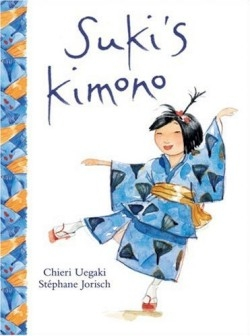Suki's Kimono
Armed with the same tenacity and unwavering determination as Henke’s precious Lily in Lily’s Purple Plastic Purse, Suki takes center stage. The comparison stops there, however, as the story’s tone evokes more reverence than sass in the face of adversity.
When Suki’s grandmother (obachan) visits for the summer, she brings a special gift from the Japanese homeland-a kimono. Memories of a delightful street festival come to life as Suki recalls the first time she donned the beautiful garb-the tasty cuisine, colorful paper lanterns, and traditional dances. Understandably, the “fan-patterned blue kimono” is Suki’s “favorite thing.” In honor of her grandmother and her rich heritage, Suki declares she will wear her Japanese robe on the first day of school!
The author is a graduate of the University of British Columbia’s Creative Writing Department and a finalist in The Writers’ Union of Canada Writing for Children Competition. This is her first children’s book, inspired by her relationship with her own grandmother.
The story, written for ages four through eight, rings true on many levels. The main character, an independent first-grader, decides to openly embrace the traditions of her Japanese ancestry. She wears her kimono, sash (obi), and wooden clogs (geta) to school, regardless of her sisters’ disapproval. Marked as the opening scene, the reader is appropriately prepared for the reaction Suki will soon receive from her classmates. Her mother, who obviously appreciates her daughter’s individuality, does not challenge her decision. Throughout the day, Suki stands tall and strong in her right to express herself as she sees fit, despite the teasing and ridicule. Only one child dares to befriend her and ask the questions no one else has the courage to ask.
The crowning moment for Suki is when the teacher asks her to tell the class what she experienced during the summer months. Suki moves to the head of the room and tells of her grandmother’s visit. As she describes the festival dancers, Suki loses herself in a graceful demonstration of a traditional dance and hums the familiar music of Japan. When she returns to her seat, her classmates, reluctant at first, reach out to her in a thunderous round of applause.
The illustrator is the recipient of the Ruth Schwartz Award for her last Kids Can Press picture book, Oma’s Quilt, as well as two Governor General’s Awards and many other artistic honors during her career as an illustrator. Here, her playful watercolors glide across the page as Suki retraces her grandmother’s dance patterns. Suki’s Kimono addresses the challenges of diversity and intolerance, and realistically explores the role played by fear of the unknown.
Reviewed by
Charisse Floyd
Disclosure: This article is not an endorsement, but a review. The publisher of this book provided free copies of the book to have their book reviewed by a professional reviewer. No fee was paid by the publisher for this review. Foreword Reviews only recommends books that we love. Foreword Magazine, Inc. is disclosing this in accordance with the Federal Trade Commission’s 16 CFR, Part 255.

